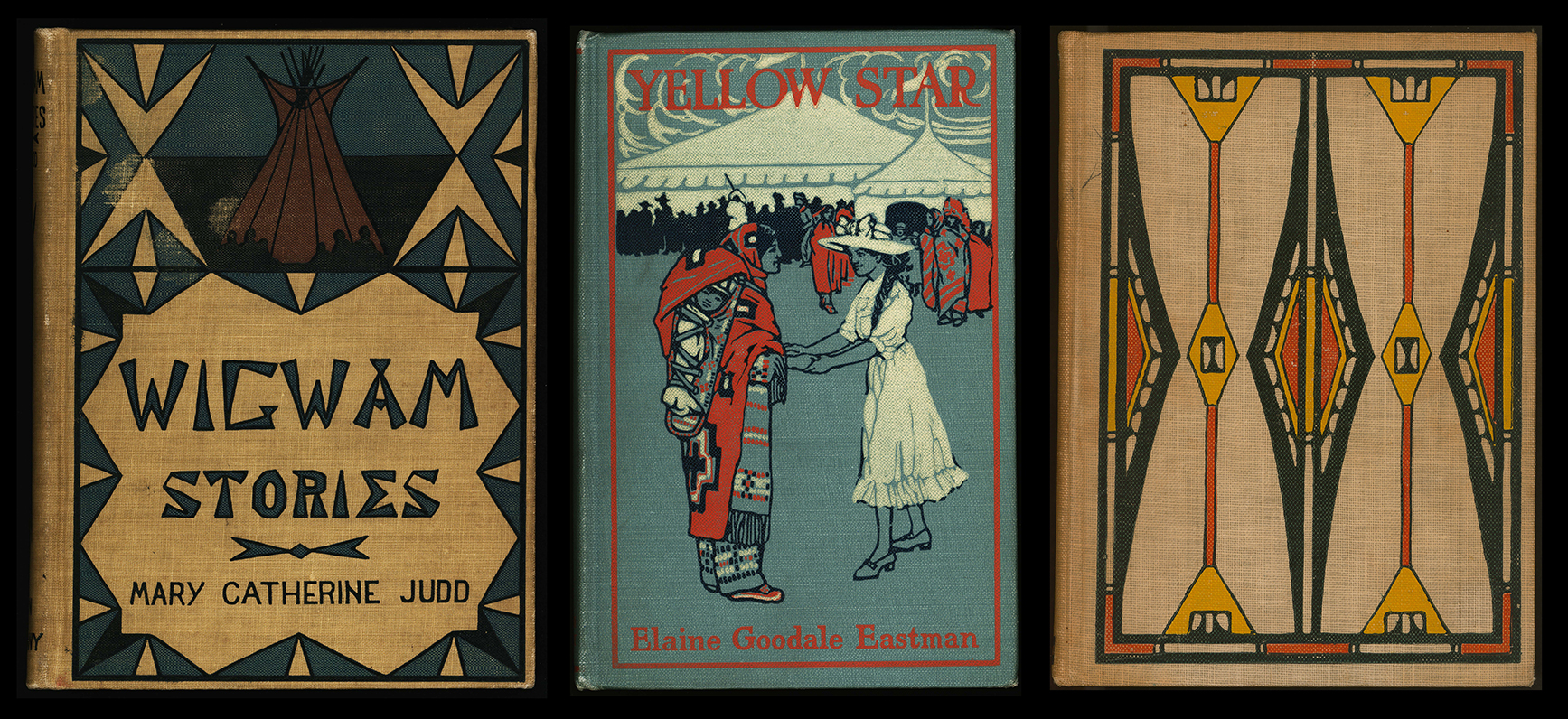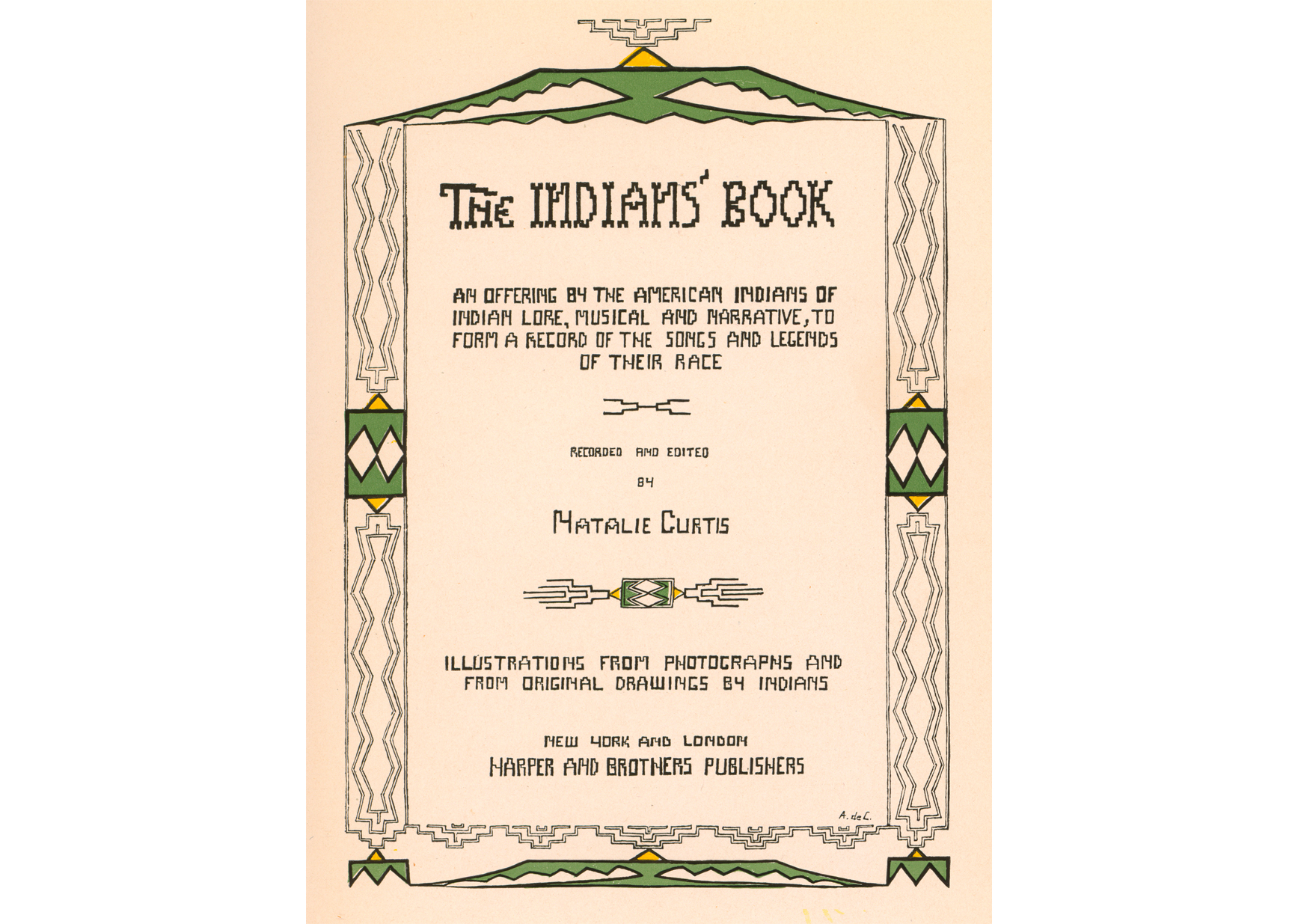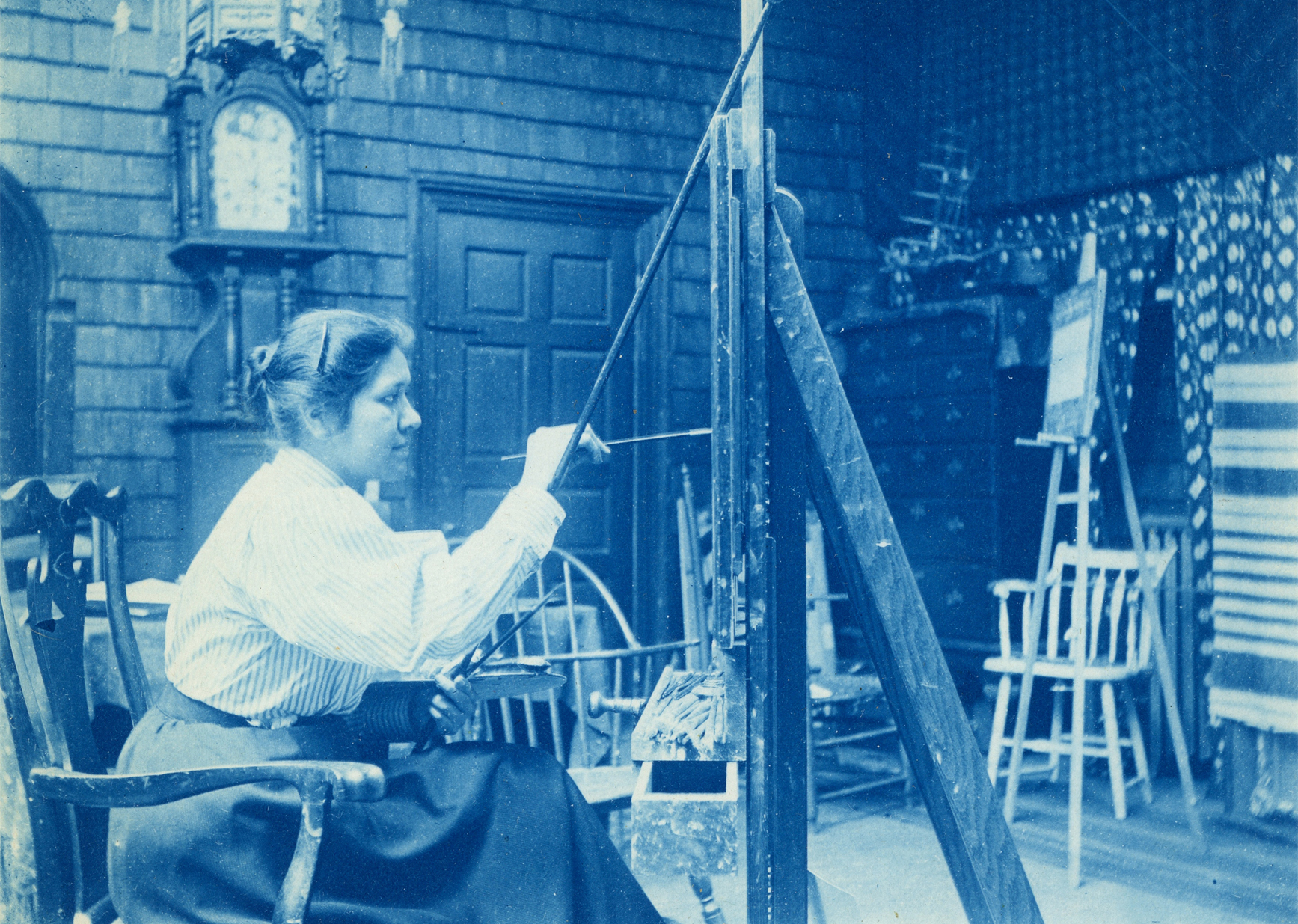Hinook-Mahiwi-Kalinaka, also known as Angel De Cora, was a Ho-Chunk (Winnebago) artist, designer, and educator. Born on the Winnebago Reservation in Nebraska in 1868 or 1869, she was forcibly removed from the reservation (“caught wild,” as she called it) to the Hampton Normal and Agricultural Institution in Virginia when she was around 14 years old (Waggoner 2008, 270n6). After graduating she attended Smith College and then Drexel Institute to study illustration under Howard Pyle, who would later recall De Cora as one of his most talented pupils.
 Left to right: Wigwam Stories told by North American Indians, by Mary Catherine Judd (Boston: Ginn & Company, 1901), Special Collections, Helen Farr Sloan Library and Archives, Delaware Art Museum. | Yellow Star, by Elaine Goodale Eastman (Boston: Little, Brown and Company, 1911), Special Collections, Helen Farr Sloan Library and Archives, Delaware Art Museum. | The Indians’ Book, by Natalie Curtis (New York: Harper and Brothers, 1923), Special Collections, Helen Farr Sloan Library and Archives, Delaware Art Museum.
Left to right: Wigwam Stories told by North American Indians, by Mary Catherine Judd (Boston: Ginn & Company, 1901), Special Collections, Helen Farr Sloan Library and Archives, Delaware Art Museum. | Yellow Star, by Elaine Goodale Eastman (Boston: Little, Brown and Company, 1911), Special Collections, Helen Farr Sloan Library and Archives, Delaware Art Museum. | The Indians’ Book, by Natalie Curtis (New York: Harper and Brothers, 1923), Special Collections, Helen Farr Sloan Library and Archives, Delaware Art Museum.
Throughout her career, De Cora illustrated and designed the covers for several books, including Yellow Star, Wigwam Stories, and The Indians’ Book by White ethnomusicologist Natalie Curtis. For the latter, De Cora was hired to design several parts of the book including the cover, which she based on a parfleche (a rawhide case used to carry objects) painted by Cheyenne artist Wihunahe (Chief Woman). She also designed the title page, its significance described in detail by Chippewa artist and designer Neebinnaukzhik Southall:
The title-page, by Angel De Cora, (Hinook Mahiwi Kilinaka), has for the motive of its design an adaption of an old Indian design which represents in highly conventionalized form the Eagle, and the Eagle’s Song. The soaring eagle is seen in the grey figure whose points are the two out-spread wings, with the tail in the centre. The paler spot at the top of the figure is the eagle’s head; from the beak rises the song – waving lines which broaden out as the song floats on the air. The whole symbol is used in decorative form throughout the page, two eagles being joined together by the tips of wings and tails to form a symmetrical design. In the centre of the page, at the top and bottom, and at the sides, is seen the eagle-symbol, while the page is framed, as it were, in the symbol of the song.
The eagle is loved and revered by the Indians. He is the strongest of all birds. He soars aloft, and he may look upon the sun, the giver of life, the celestial emblem of divine force. Therefore has the symbol of the Eagle and the Eagle’s Song been chosen for the title-page of “The Indians’ Book” (2020, par. 6).
 Title page for The Indians’ Book, by Natalie Curtis (New York: Harper and Brothers, 1923). Angel De Cora (c. 1868-1919). Special Collections, Helen Farr Sloan Library and Archives, Delaware Art Museum.
Title page for The Indians’ Book, by Natalie Curtis (New York: Harper and Brothers, 1923). Angel De Cora (c. 1868-1919). Special Collections, Helen Farr Sloan Library and Archives, Delaware Art Museum.
Perhaps her most notable contributions to The Indians’ Book are the title page decorations for the chapters, which are inspired by specific tribal legends and songs. The publishers were expecting the designs to be the same for each chapter, but De Cora surprised them by creating distinctive lettering based upon each tribe’s own motifs. Southall explains the design of De Cora’s Winnebago title page:
For the Winnebago title page, DeCora created an illustration based on loom beadwork made with glass seed beads, likely based on a garter worn around the knees to hold up leggings, or perhaps an armband. The center of the design is depicted in detail, which then fades out to strings rendered in a wash. The pattern is very typical for Great Lakes tribes, and is also seen in Anishinaabe designs [. . .]. DeCora’s letters draw from the beadwork design, not only in the green and orange color scheme, but also in their use of square motifs as anchors flanked by triangles. DeCora also uses the stepped form in most of the letters, notably the K, and the jagged floral-like form in several letters — the two Es, the W, and G (2020, par. 17).
 Chapter title page lettering for The Indians’ Book, by Natalie Curtis (New York: Harper and Brothers, 1923). Angel De Cora (c. 1868-1919). Special Collections, Helen Farr Sloan Library and Archives, Delaware Art Museum.
Chapter title page lettering for The Indians’ Book, by Natalie Curtis (New York: Harper and Brothers, 1923). Angel De Cora (c. 1868-1919). Special Collections, Helen Farr Sloan Library and Archives, Delaware Art Museum.
Curtis would later write that the publishers were so pleased with De Cora’s work that they paid her more than she was expecting.
In 1906 De Cora accepted the position as art teacher at Carlisle Indian School in Pennsylvania on the condition that she “shall not be expected to teach in the white man’s way, but shall be given complete liberty to develop the art of my own race and to apply this, as far as possible, to various forms of art industries and crafts” (Curtis 1920, 65). Throughout her nine years at Carlisle, De Cora revamped the curriculum to do just that, teaching her students that their inherent artistic talent was worthy of recognition and deserving of a place in the larger arena of American art.
De Cora died in 1919 of pneumonia brought on by the influenza pandemic of 1918-1919. In a memorial published in The Outlook, Curtis wrote, “The death of Angel De Cora, the first Indian artist to express in the white man’s world what her people might become, should rouse us to a keener realization of the significance of her conviction: ‘My people are a race of designers. I look for the day when the Indian shall make beautiful things for all the world’” (Curtis 1920, 65).
Rachael DiEleuterio
Librarian/Archivist
References and Further Reading:
Curtis, Natalie. “An American Indian Artist.” The Outlook, January 14, 1920, 64-66.
De Cora, Angel. “Angel DeCora—An Autobiography.” The Red Man by Red Men, March 1911, 279-80, 285.
Southall, Neebinnaukzhik. “This Just In: Angel DeCora’s The Indians’ Book and Wigwam Stories.” December 7, 2020. https://letterformarchive.org/news/view/angel-decoras-lettering-in-the-indians-book
Waggoner, Linda. Fire Light: The Life of Angel De Cora, Winnebago Artist. Norman, OK: Oklahoma University Press, 2008.
Top image: Angel De Cora, c. 1897. Anna W. Hoopes’ photo album, 1897 – c. 1898, Frank E. Schoonover Manuscript Collection, Helen Farr Sloan Library and Archives, Delaware Art Museum.

